Reduce Your Digital Carbon Footprint And Go Green With Media Optimization
Did you know that a staggering 2.8 Zettabytes of data (1 ZB is approximately 1,000,000,000 TB) are transported on the Internet annually? Such volumes of data require an incredible amount of energy which impacts our environment. As much as it’s easy to Google something on our smartphones, paying attention to the often unseen digital carbon footprint is essential.
And no, we don’t mean drastic changes like not using digital devices or the Internet altogether (we all have to work, don’t we?) but rather, making small changes. If you’re a business owner, IT manager or Marketing Manager, we’re sharing how optimizing your images can help you scale down your carbon emissions and go green!
What is a Digital Carbon Footprint?
Modern technologies have helped streamline processes and decrease the consumption of finite resources that we frequently use for work, such as paper. But have you thought about how your online behaviour affects the environment?
What is a digital footprint and how does it produce carbon emissions? The concept of a digital carbon footprint works similarly to carbon footprints, and the only difference is that it applies to activities we do in the digital world. It refers to the amount of carbon dioxide and other greenhouse gases produced when we use and connect these digital devices (mobile phones, desktops and laptop computers) to the internet.
How is a Digital Carbon Footprint produced?
When we use the internet, data is processed, transmitted and stored in massive data centres worldwide that are powered 24/7 to transmit information to and from our digital devices. Our digital world, which brings great convenience at the touch of a button in actual fact, leaves a trail of emissions on planet Earth.
According to The Shift Project, the carbon data footprint of our digital devices, the internet, and its supporting systems emit about 4% of greenhouse emissions globally. This figure is expected to double by 2025 as image and video-heavy social media networking sites like Facebook, Instagram, YouTube, and Tik Tok become more popular, requiring a lot of electricity and data centre resources.
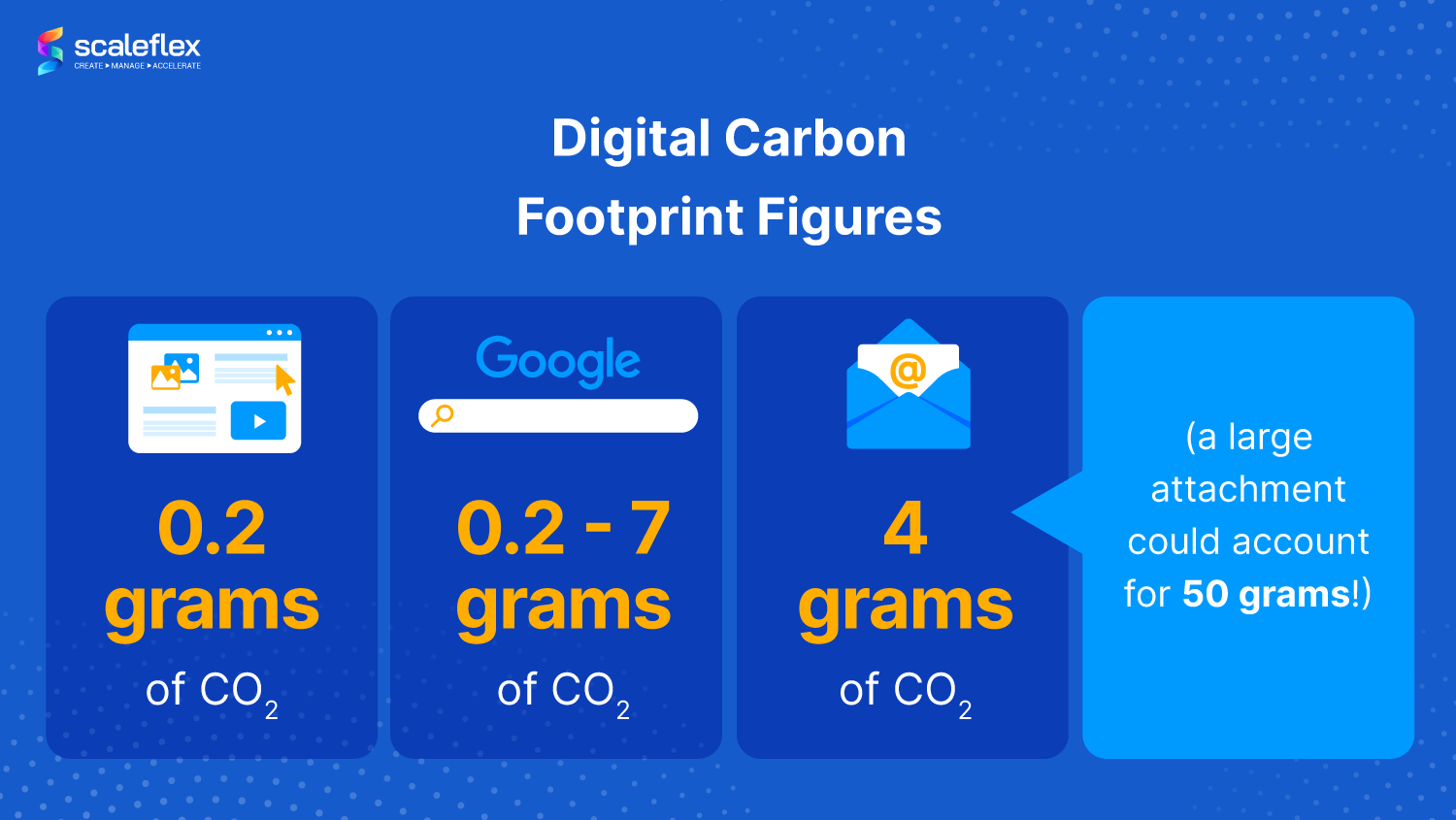
Similar to reducing carbon footprints, there are ways for consumers and businesses looking at digital sobriety to lessen the environmental impact.
How to measure the carbon footprint of my website?
With companies paying more attention to digital sustainability, there are many tools available that help to measure the carbon footprint of a website:
- Websitecarbon.com: An online carbon footprint calculator, created by Wholegrain Digital
- Quanta.io: An enterprise SaaS with a tool that measures both web performance and carbon footprint of a website
- Ecoindex.fr: An open-source API that makes it possible to evaluate the environmental performance and footprint of a website.
What are the current trends in Green Businesses and Sustainability?
Green businesses and sustainability have recently taken the world by storm and are one of the most important factors driving business growth and innovation. A survey by Forbes found that 92% of customers are more likely to trust companies that champion social and environmental concerns.
Over the past decade, one of the most popular trends in business has been the growing demand for sustainable practices. In our current global climate of rising temperatures and diminishing resources, more and more companies adopt green approaches to improve their environmental impact. Though conservation and sustainability are often thought of as topics that are confined to the physical environment, increasingly more experts are turning their attention to the impact of online activities on the environment.
Tech giants have been working to reduce their online carbon footprint. Google announced that it utilizes 100% renewable energy to offset carbon emissions, whereas Microsoft (who owns the search engine Bing) has pledged that by 2030, it will be carbon negative. Apple, too, stated that all its products will be carbon neutral by 2030.
Green companies, eco startups and environmentally friendly companies have also emerged, such as Ecosia, which offers innovative ways by planting trees whenever you search the web by using their extensions on your browsers. They use the profit from search ads to generate income that is “returned” to nature with new trees; reducing environmental impact!
Scaleflex’s next wave of disruption too, also involves sustainable business practices, empowering businesses to reduce digital carbon footprint and rationalize the type of technologies used and their impact on the environment.
How can businesses play a part in reducing their digital carbon footprints?
Larger enterprises like Google, Microsoft and Apple can dedicate an entire team and resources to reduce their electronic carbon footprint. The same might be more challenging for small and medium businesses and start-ups.
So, what can companies do to make sure that their business practices online are sustainable without compromising growth? What resources are out there to help keep your online carbon footprint low?
Here, at Scaleflex, we offer some ways for digital businesses to go green and lower carbon footprints!
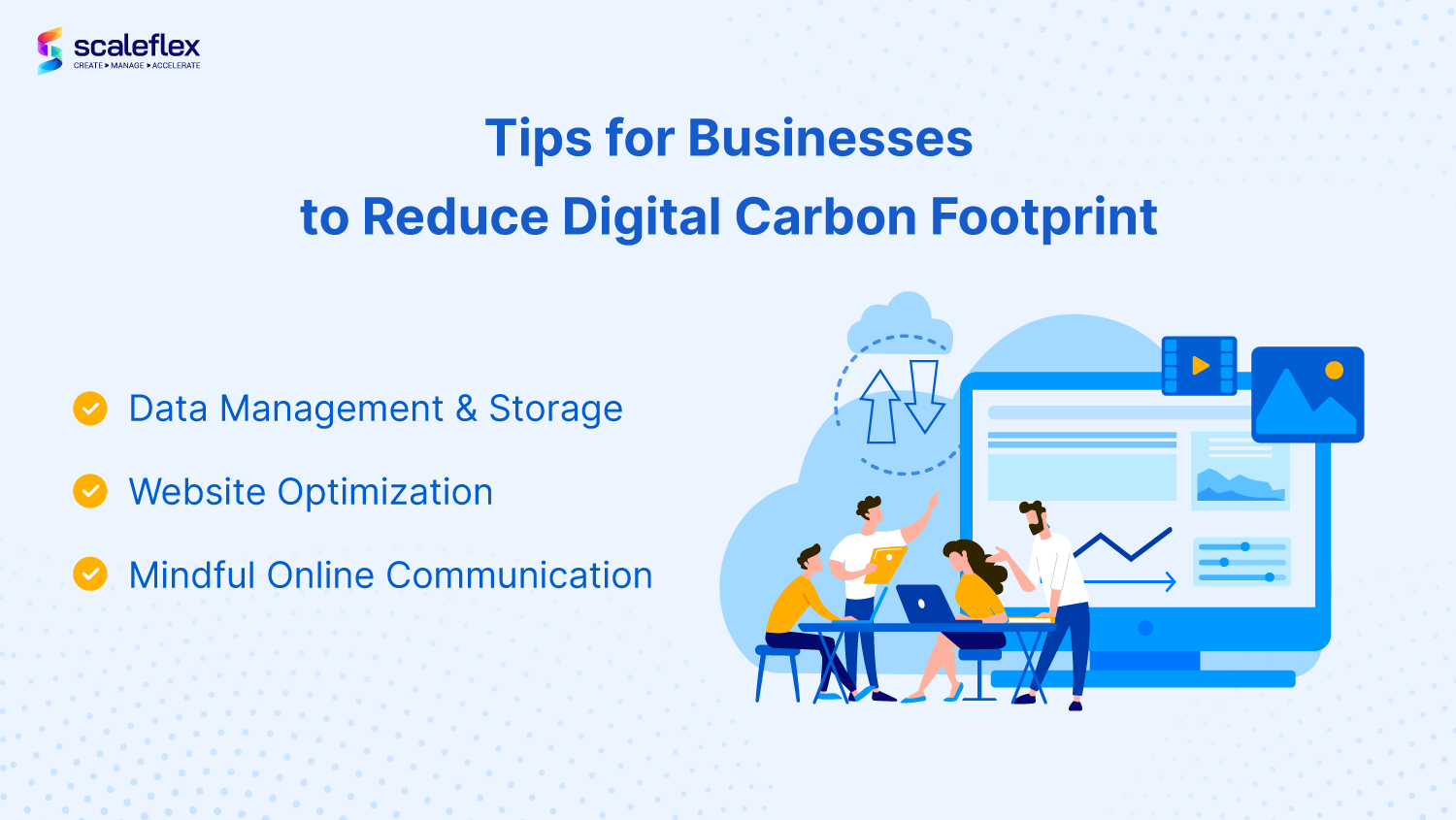
Review Data Management & Storage
Start by doing a ‘Marie Kondo’ - decluttering digital assets that no longer spark joy (unused or archived). By 2025, global cloud storage will reach 100 zettabytes of data - or a trillion gigabytes. Cloud storage is expensive when you have more assets, and it also produces lots of carbon that you don’t see from sprawling server farms.
If you have documents with v1, v2, v3… I’m sure you don’t need all of them. Especially for visual assets and rich media like images and videos, these take up significant space in the cloud. It’s time to clean them out periodically. The same should be done in workplaces too.
At Scaleflex, our Digital Asset Management, Filerobot, has the ambition to become the single source of truth for all media assets, preventing the users from repeatedly replicating media files among various third party tools (CMS, PIM, Emailing, Marketing third party tools, etc.) Some of the features include automated duplicate management and versioning control that can help reduce cloud storage. With Filerobot, you can remove unnecessary digital assets and ensure your team members have the latest on-brand assets.
Website Optimization
According to WebsiteCarbon, the average web page creates 1.76g of carbon dioxide for each page view. A website with 10,000 page views per month emits 211kg of carbon dioxide annually.
A lighter and faster website is also a greener one! Website optimization not only can help you speed up your page speeds, do better in SERP, reduce bounce rates, and increase conversions, it also helps lower your business’ carbon footprints.
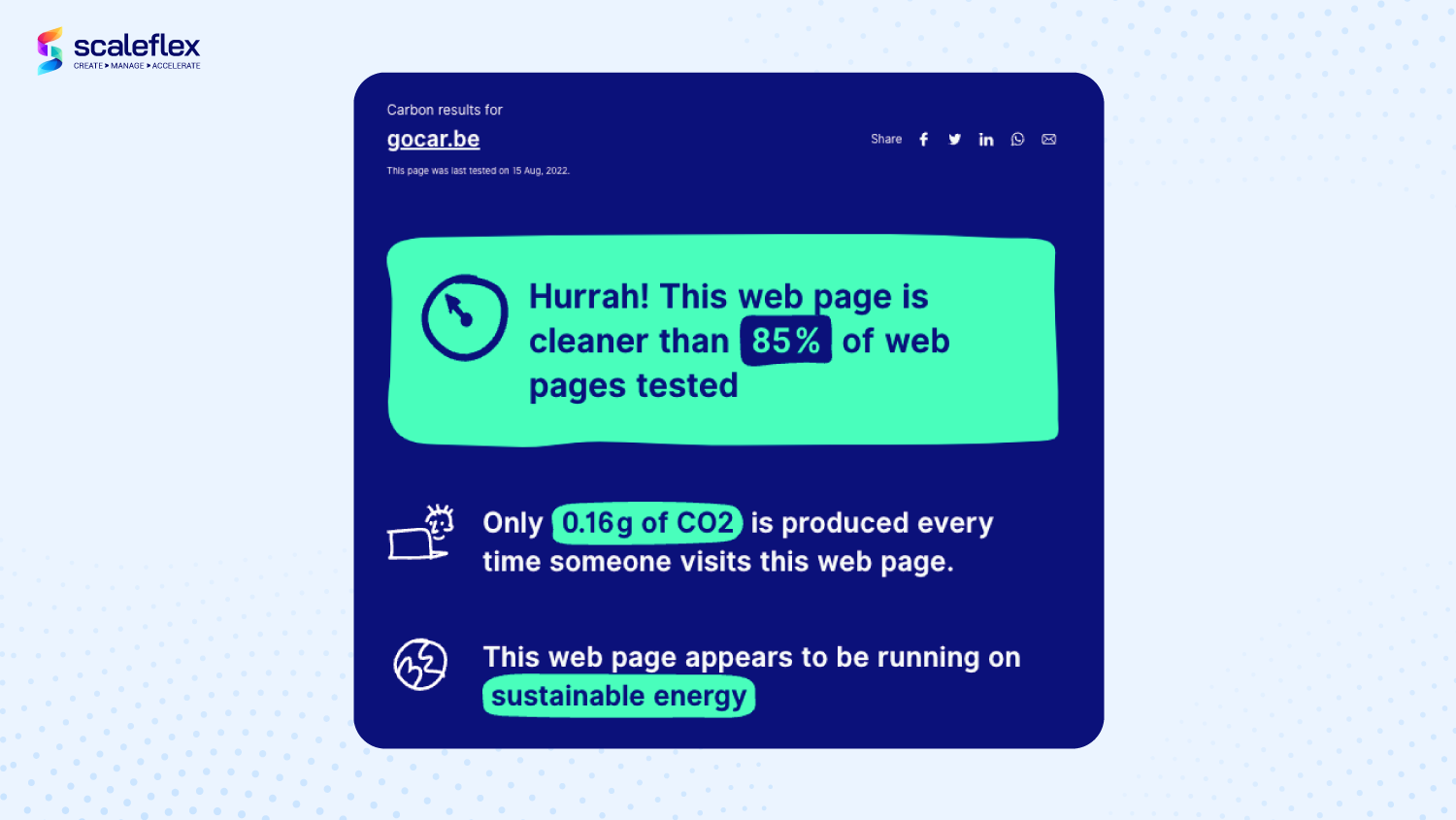
Image Optimization
As consumers desire more aesthetically-pleasing websites, optimizing your images is the most crucial way to reduce website data, lower network resources, and increase the speed at which it loads.
You can do this by compressing and resizing large images on your websites, choosing modern image formats (WebP and AVIF) that load fast, and adopting lazy loading and responsive images. We won’t detail how you can do all these in this blog post, but if you are interested in the specificities, we’ve gone through them here: Optimizing Images for Web.
Video Optimization
Other than images, videos are another considerable challenge. Streaming videos account for large amounts of data transmitted to and fro servers. An excellent way to reduce its carbon footprint is to embed videos that are already on other video sharing sites like YouTube. This allows your video to be played from your website while allowing YouTube to take on that data load. According to the ClickClean report, YouTube is rated A in terms of eco-friendliness, so you can still play these videos while being mindful of the environment!
Scaleflex’s solutions: Filerobot can help you optimize your websites with on-the-fly image transformations so you don’t have to use up cloud storage with your image variants! Videos can also be optimized with Video Transcoding and Adaptive Streaming to deliver the best resolutions to your end-users.
Write Clean Codes
Codes that are neat and streamlined are inherently beneficial. Avoid redundancy and construct efficient queries by keeping your code clean and straightforward. For developers, Sandi Metz’s rules may be useful:
- No longer than 100 lines of code for classes
- Below 5 lines of code for methods and functions
- No more than 4 parameters into a method
- Instantiate only 1 object for controllers
Reduce Javascripts
JS adds file weight to the web page and increases the processing time required. Not only will these cause slow page loading times, it is also bad for the environment.
Not all Javascript on a website can be useful. Especially with popular CMS like WordPress, plugins or third-party codes can cause bloat. Google’s PageSpeed Insights can provide some information and narrow down which files take a long time to load. If these files are not needed, you should remove them.
Network Optimization
Websites without Content Delivery Networks (CDNs) are dynamically generated each time an individual visits the web page, requiring server processing and increasing energy consumption. Caching technologies can help to lower such inefficiencies by pre-generating static versions of the page.
A lot of energy is also used to transmit data through telecommunication networks from one end of the globe to another. With today’s businesses transcending geographical locations, there is a need for European E-Commerce sites to deliver content to people living in the United States or Asia, and vice versa. CDNs then help businesses lower network latency and the demand for energy by reducing the distance data travels to the end-users. This means accelerated content, faster websites, and lower carbon emission.
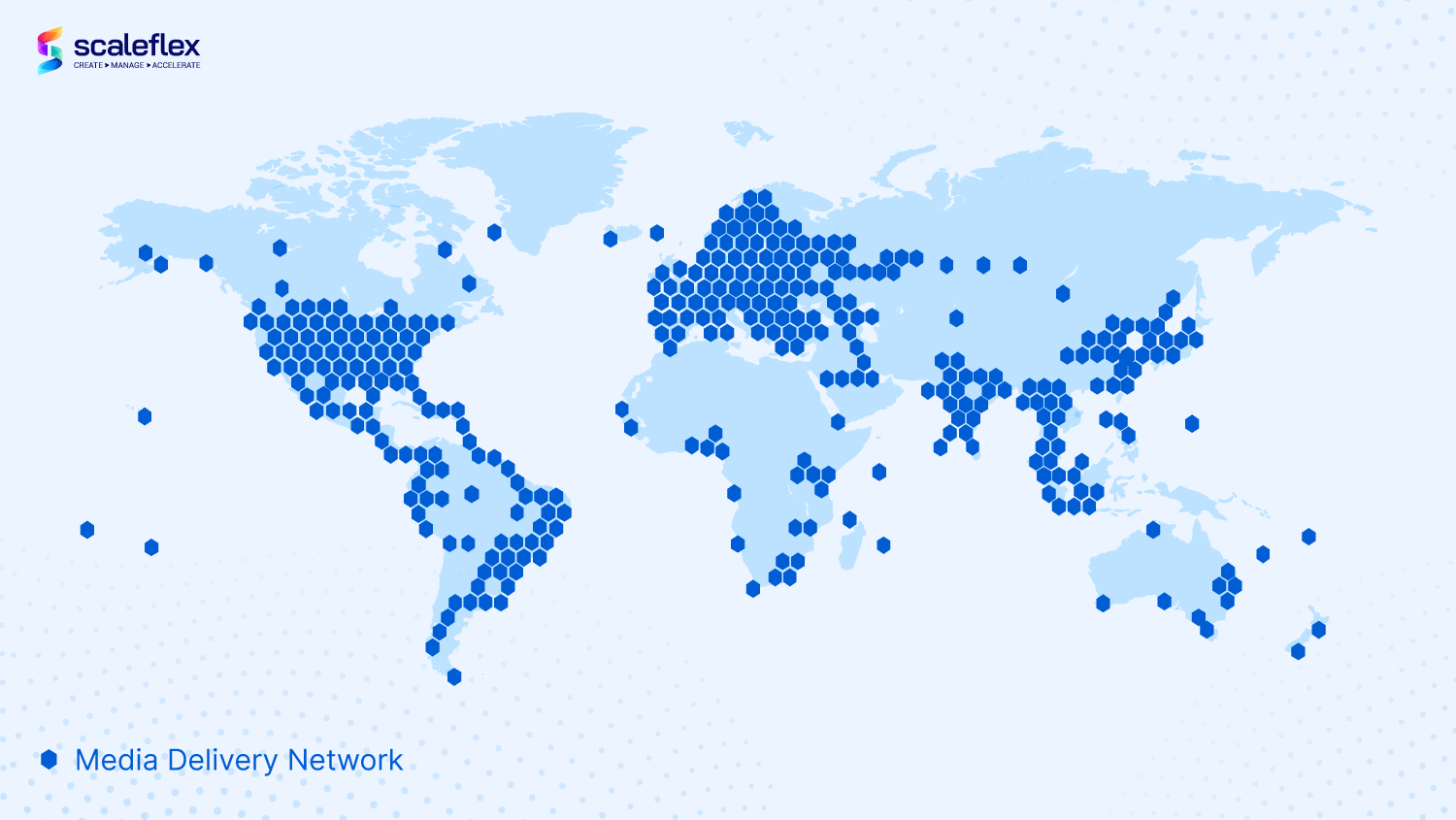
Scaleflex’s solutions: Our multi-CDNs provide best-in-class caching and the fastest delivery of digital assets worldwide with over 130 countries, 5 continents, and 2,000 Points of Presence.
Mindful Online Communication
Reducing online carbon footprints has to be a company-wide initiative. It is insufficient just for the management or the IT team to implement the solutions as mentioned above. Every employee, too, can play a part in conserving the environment.
This can be done by having a company-wide culture of mindful online communication strategies in the workplace.
Even though sending an email or a message in the company chat group is still more environmentally friendly than a physical letter, it still produces carbon emissions. When working together in the same office, you’ll find it more productive to speak to a colleague in-person, rather than sending a long email and having several to-and-fros to clarify what you actually mean. If you need to send an email, ensure that the information is complete.
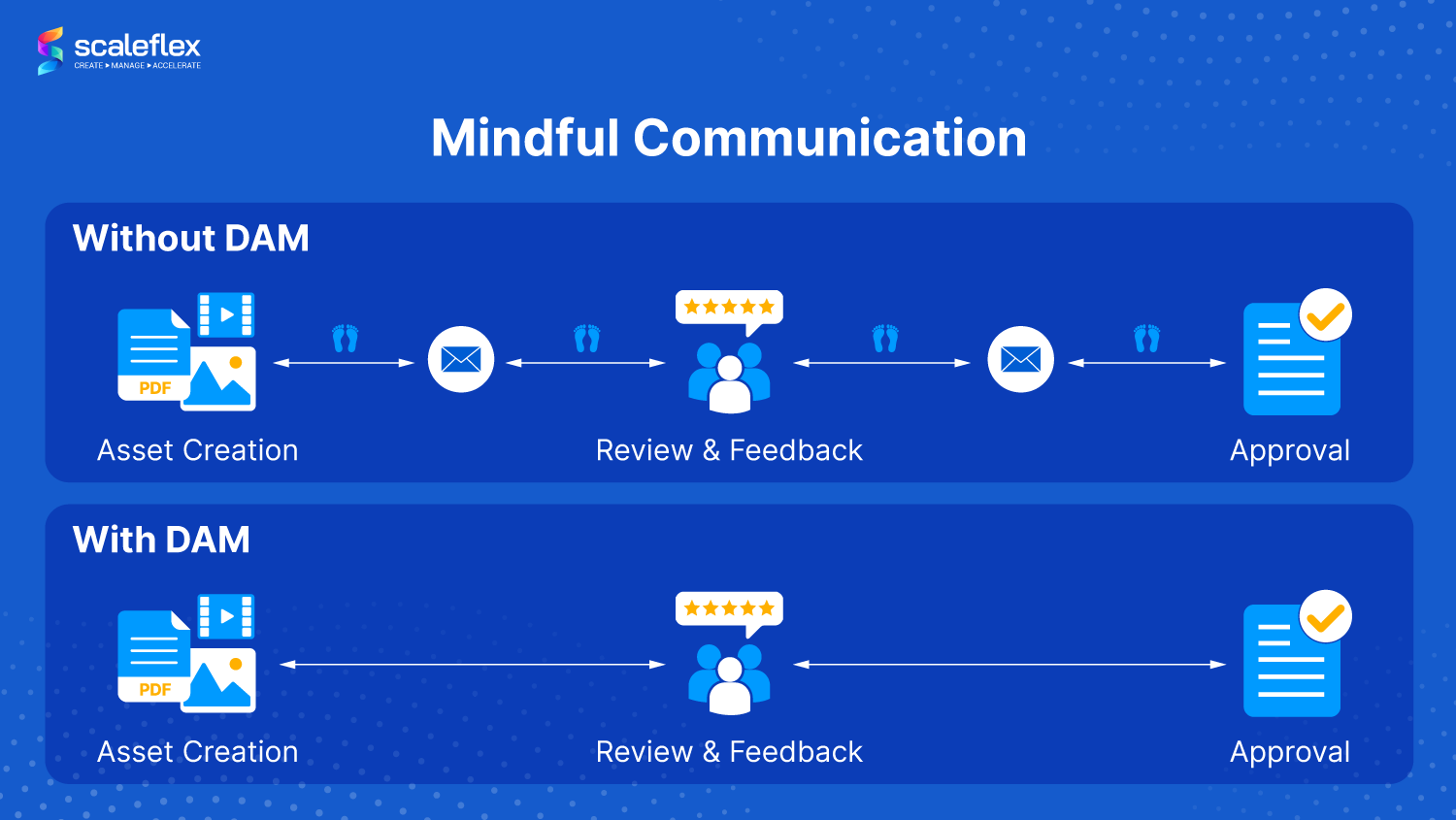
Visual content on emails, like websites, equates to carbon emissions. While a regular email may produce 4g of carbon, an email with an image attached can create 50g of carbon. Instead, a centralized Digital Asset Management solution to store and share files, images and videos may help to reduce the email clutter. The DAM can also help minimize superfluous notifications - no more waiting for that email at the end of the day to begin your part of the project. Approval processes can be done from within the DAM.
Sure, implementing a DAM doesn’t directly equate to using a sustainability management software or that we are completely eradicating our online carbon footprint, just that we can help to reduce the unnecessary ones from to-and-fro online communication.
Scaleflex’s solutions: Filerobot as the single-source-of-truth, allows for seamless content sharing with internal and external teams. Feedback and approval processes can be done from a single platform, thus reducing the reliance on emails or communication tools that increase carbon emissions.
Conclusion
With the growing importance of sustainability and its effect on our environment, we will likely see more businesses adopt sustainable strategies and green software in the coming years.
The growing shift toward green businesses means that optimizing your company's online carbon footprint will be an increasingly important trend in the years to come. Adopting the above strategies through implementing a Digital Asset Management solution like Filerobot are some of the small but impactful ways to reduce the online carbon footprint of your business.
Want to learn more about how you can take advantage of optimizing web performance and reducing the carbon footprint of your websites? Join Scaleflex, Quanta, and Michelin in our online webinar to find out more. Watch the replay.
The future is green; reduce the digital carbon footprint of your business with Scaleflex!





